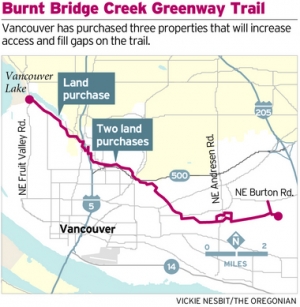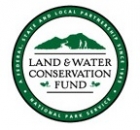Where does conservation money come from?
By Jean Akers, November 20 2013
 Few of us, myself included, have the money to buy everything we want. My choices are usually to save for later, work harder, earn more, want less or forget the object of my desire.
Few of us, myself included, have the money to buy everything we want. My choices are usually to save for later, work harder, earn more, want less or forget the object of my desire.
When it comes to park agencies in The Intertwine, we already know that most don’t have the money to buy the land that they want to connect our parks, trails and natural lands, and help establish ideal green infrastructure systems.
So should these agencies simply want less? Forget the object of their desire? Personally, I’d rather see us, the partners of The Intertwine Alliance, working harder to keep our parks agencies hard at work.
 How? Well, speaking of things we probably all know, let’s agree that grant funding for parks is both limited and competitive. In my six years as a park planner in Vancouver and Clark County, I’ve gained direct experience cobbling together funding sources for our natural areas and new parks and trails. My typical patchwork of funding options could be some combination of the city/county general fund (property taxes), park impact fees, real estate excise taxes, conservation futures funds, partnering agencies, private donors and community, state and federal grant programs.
How? Well, speaking of things we probably all know, let’s agree that grant funding for parks is both limited and competitive. In my six years as a park planner in Vancouver and Clark County, I’ve gained direct experience cobbling together funding sources for our natural areas and new parks and trails. My typical patchwork of funding options could be some combination of the city/county general fund (property taxes), park impact fees, real estate excise taxes, conservation futures funds, partnering agencies, private donors and community, state and federal grant programs.
Which brings me to a third thing we might intuit: every grant program can prove critical to leveraging a public land purchase, trail connection, or park project.
 One of most important funding sources we Intertwiners can access -- the federal Land and Water Conservation Fund (LWCF) -- needs our help. The LWCF, created in 1965 and funded (albeit never fully) through federal royalties from offshore oil and gas development, will be up for reauthorization in 2015.
One of most important funding sources we Intertwiners can access -- the federal Land and Water Conservation Fund (LWCF) -- needs our help. The LWCF, created in 1965 and funded (albeit never fully) through federal royalties from offshore oil and gas development, will be up for reauthorization in 2015.
Over its 50-year history, LWCF -- created to protect America’s natural resources and outdoor recreation assets -- has supported many land acquisition and development projects on my side of the Columbia River. Clark County, Vancouver, Ridgefield, Camas, Battle Ground and Washougal have all received LWCF funding support, capturing over $3 million since 1976.
As a coalition, The Intertwine Alliance can provide visible support as LWCF is evaluated, pushing not only for the fund’s reauthorization, but also for improvements that would give the parks agencies of The Intertwine an extra boost.
Recommended LWCF improvements from the Society of Outdoor Recreation Professionals (SORP), of which I’m a member, would:
 See LWCF fully and permanently funded at $900M annually;
See LWCF fully and permanently funded at $900M annually;- Specify a percentage of monies to be directed to urban populations;
- Allow monies to be used for restoring and repurposing existing facilities and areas; and
- Add language that makes allocation of monies feasible for larger regional landscapes like the Columbia River watershed (and The Intertwine!)
If we want to keep the parks agencies of The Intertwine hard at work, we can start by looking at the tools we already have in our coalition toolbox: the power to raise the volume on a critical conversation. Let’s ensure that LWCF funding gets fully authorized -- and that urban regions like The Intertwine get the attention we deserve. Visit the SORP website for more info on the need to adapt and reauthorize LWCF.


 Through her work, Jean Akers, both landscape architect and certified planner, promotes conservation and sustainable outdoor recreation for park and trail systems in the Pacific Northwest and beyond. She also serves on the Board of the
Through her work, Jean Akers, both landscape architect and certified planner, promotes conservation and sustainable outdoor recreation for park and trail systems in the Pacific Northwest and beyond. She also serves on the Board of the
Add new comment